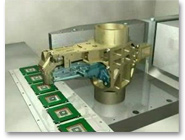Building a robot hand
Robots don’t necessarily have to resemble people. There are robots that look like a baked beans can on wheels, while others are like hands that are used to weld car parts. This experiment shows you how to use your hand as a model to make a robot hand.

You will need:
- A worn out thin bendable piece of plastic – for example from an old document cover.
- Cardboard from food packets like cornflakes boxes.
- Felt tip pen or pencil
- Thick plastic straws
- Adhesive tape
- A pair of scissors
- Glue
- String or twine
- Three springs from roller-ball pens
- A large match box; and
- A stapler
And last but not least ... a helping hand from an adult.
We want your feedback!
Have you tried the experiment?
Do you have comments?
Do you need any help?
Contact us at feedback@xlab.tv and tell us about it!
Method
The robot hand will be made up of three identical fingers.
Start by tracing around a finger on the plastic document holder, and marking the position of the joints, that is, the points where your fingers bend. It is very important that you make this finger about five centimetres longer than your finger. Next cut out the plastic finger and make a copy of it out of cardboard. Now cut out the cardboard finger as well. Repeat until you have three plastic fingers and six cardboard fingers.
Glue the cardboard fingers in pairs, cut them at the joint lines and trim about two millimetres from each end at the markings for the joints, so that the robot hand will be able to move.
Stick the cardboard pieces onto the plastic fingers leaving the 4mm gaps at the joints. When the glue sets, take the springs and fix one to the second joint of every finger - i.e the one furthest from the tip of the finger. Use a stapler to fix the springs but be extra careful not to crush the springs.
After you have fixed all the springs, take the straws and cut them into six pieces. The pieces of plastic straws should be shorter than the cardboard “bones”. Now glue the straw pieces onto the first and last bones of the fingers on the same side as the spring. Hold them in place with some adhesive tape.
Next pass the twine through the straws, through the spring, and through the last straw. Secure the twine to the end of the last bone – again using the stapler. And hey presto there’s the first wiggly finger! Just pull the string gently and the finger twitches. Let go and the spring pushes it back to its original position.
All that’s left to make the hand is to fix the fingers to the matchbox: two on one side, and one, between them but on the other side to act like a thumb helping the other fingers to grab objects.
Fix another piece of plastic straw to one of the remaining free sides of the matchbox, perpendicular to both the fingers and pass the three pieces of twine through it. This is your “wrist”. Your robot hand is ready! Just pull the string and the hand closes.